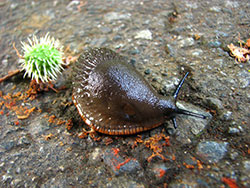Slugs, a common garden pest, are snails without a shell. Size can vary from one-fourth inch to two inches depending on age and species. They spend the winter as pearl-like eggs in protected places, usually under plant debris. The eggs hatch in 2-4 weeks and can grow for up to 2 years before reaching maturity.
What do slugs eat?

Feeding occurs primarily in the evening and on dark, cloudy days. Slugs are very destructive and are difficult to control. They eat irregularly-shaped holes in tender plant tissues, leaving a slime trail behind.
What environments do slugs thrive in?
Slugs require a cool, moist environment and won’t survive long under dry, warm conditions. Slug populations thrive under frequent irrigation, heavy shade and high plant densities that keep soil cool and moist.
How can I manage the slug population in my yard?
Several cultural practices can help manage slug problems. For example, slugs can be quickly eliminated by creating a drier, warmer soil surface. Drip irrigation, plant spacing and increased air circulation are recommended management tools. New research from the USDA shows that a 2% solution of caffeine (coffee) kills slugs while a weaker solution takes away their appetite. Maintain permanent walkways of clover, sod or stone mulches to encourage predatory ground beetles. Repel slugs with copper strips fastened around trunks of trees or shrubs. Encircle tend and young seedlings with a protective barrier of crushed eggshells
Good yard sanitation that eliminates daytime hiding places helps control slugs. Or, you can create hiding places that serve as traps. Simply place wet newspapers or boards in the garden. The slugs hiding underneath should be destroyed each morning.
Beer or yeast traps also are effective and easy to make. Just bury a shallow can or bowl to the rim of the container and fill it with beer or a yeast mix. Slugs are attracted to the yeast, fall in and drown. You will need to clean out the traps frequently and replenish them with beer or yeast mix.
Are slug baits useful in controlling slugs?
When using commercial slug baits, apply them to cool, moist soil in protected places, like under plants. It’s important to note that commercial baits are toxic to children, birds, dogs and cats that may be attracted to the product. Consider using baits containing iron phosphate. These commercial products are less injurious to pets.
Gardening techniques that help dry and warm the soil surface between plants are most effective for managing slug problems.
For more information, see the following Colorado State University Extension fact sheet(s).



